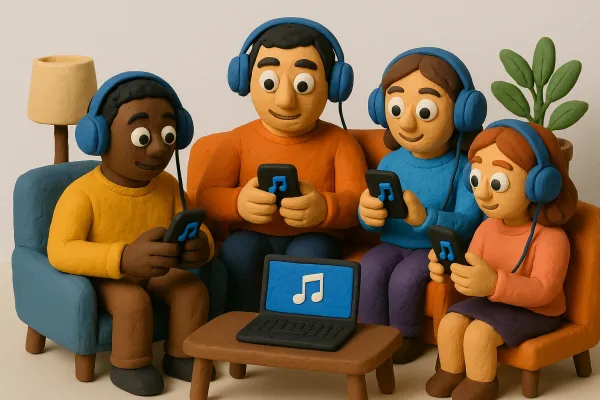Exploring the Spotify Top Monthly Listeners List: Who's Dominating the Charts in 2025?

Spotify has become the go-to platform for music lovers worldwide, and in 2025, it's still setting the stage for who's who in the music industry. With millions of monthly listeners, the "Spotify top monthly listeners list" offers a unique glimpse into which artists are capturing hearts and streams globally. From seasoned legends to rising stars, the list tells a story of evolving tastes, viral moments, and the power of playlists.
Key Takeaways
- Spotify's monthly listeners metric highlights unique users engaging with an artist's music in a 28-day window.
- Collaborations and playlist placements play a huge role in boosting an artist's listener count.
- The list often features a mix of established names and breakout artists, reflecting diverse audience preferences.
- Non-English tracks and global genres are increasingly making their mark on the charts.
- Artists rely heavily on fan engagement and viral trends to climb the Spotify listener rankings.
The Reigning Stars of Spotify in 2025
How Monthly Listeners Define Success
When we talk about success on Spotify, monthly listeners are the gold standard. It’s not just about how often a song is played but how many unique people are tuning in. Think of it like this: streams might tell you how catchy a track is, but monthly listeners? That shows an artist's reach. Take Bruno Mars, for example. With a staggering 150,724,675 monthly listeners, he’s not just making hits—he’s bringing a global audience together. The list of top Spotify artists this year proves that connecting with listeners worldwide is what really sets the stars apart.
Genres That Dominate the Charts
Pop, hip-hop, and Latin music are still ruling the Spotify charts in 2025, with a few surprises here and there. Why? These genres have a knack for blending catchy beats with lyrics that stick in your head. But it’s not just about the big names. Emerging artists in these genres are finding their way into curated playlists, giving them a shot at the big leagues. And let’s not forget the rise of non-English tracks—proof that music truly has no language barrier.
The Role of Collaborations in Rankings
If there’s one thing we’ve learned, it’s that collaborations are like rocket fuel for an artist’s career. Think about all those tracks where two (or more) big names come together—it’s almost guaranteed to climb the charts. These partnerships aren’t just about blending fan bases; they’re about creating something fresh and exciting. In 2025, we’ve seen artists teaming up across genres, breaking boundaries, and reaching new heights. It’s a win-win for everyone involved, especially the fans.
Breaking Down the Spotify Top Monthly Listeners List
What the Numbers Really Mean
When Spotify says an artist has X million monthly listeners, they’re talking about unique users who’ve streamed at least one of their songs in the past 28 days. It’s not about how many times a track gets played but about how many different people are tuning in. This makes it a great way to measure an artist’s reach, not just their repeatability.
Take Bruno Mars, for example. As of February 2025, he’s leading the pack with 140 million monthly listeners. That’s 140 million unique accounts pressing play on his music. It’s a staggering number that shows how far his sound travels, but it doesn’t necessarily mean he’s the most streamed artist overall.
The Difference Between Streams and Listeners
Here’s where it gets tricky: streams and listeners aren’t the same thing. Streams count every single time a song is played, even if it’s on repeat. Monthly listeners, on the other hand, only count each user once, no matter how many times they hit replay.
- Streams: Great for showing a song’s popularity over time.
- Listeners: Perfect for measuring how broad an artist’s audience is.
This distinction is why a one-hit wonder can sometimes have more monthly listeners than an artist with a deep catalog. A viral track can blow up an artist’s listener count, even if their other songs are barely touched.
How Playlists Shape the Rankings
Playlists are a huge deal on Spotify. Whether it’s a curated playlist like “Today’s Top Hits” or user-generated ones, they can make or break an artist’s listener count. Songs added to popular playlists often see a massive spike in streams and, by extension, monthly listeners.
- Seasonal Playlists: Think holiday hits. Artists with Christmas songs see their listener numbers explode every December.
- Collaborative Playlists: Featuring multiple artists, these can introduce new listeners to lesser-known musicians.
- Algorithmic Playlists: Like “Discover Weekly,” these are tailored to user preferences and can give smaller artists a big boost.
Spotify’s monthly listener metric might not tell the whole story, but it’s a fascinating snapshot of who’s connecting with audiences right now.
The Global Influence of Spotify's Top Artists
Artists Bridging Cultures Through Music
Music has always been a universal language, but Spotify has taken it to the next level. Artists today are creating tracks that mix genres from different parts of the world, like Afrobeat meeting electronic or reggaeton blending with pop. These cross-cultural collaborations aren’t just cool—they’re changing how we experience music globally. Think about it: when was the last time you heard a song and didn’t even realize it was in a different language until you looked it up? That’s the beauty of today’s music scene.
Here’s why this matters:
- Exposure to New Sounds: Spotify’s playlists introduce us to artists we’d never find on our own.
- Collaboration Opportunities: Artists from different countries are teaming up more than ever.
- Cultural Appreciation: Fans are diving into the stories and traditions behind the music.
The Rise of Non-English Tracks
It’s 2025, and songs in Spanish, Korean, and even Hindi are topping the charts. Non-English tracks aren’t just niche anymore—they’re dominating. BTS, Bad Bunny, and Rosalía have paved the way, but now newer artists are joining the global stage. Spotify’s algorithm plays a big role here. By recommending tracks based on vibes rather than language, it’s breaking down barriers.
For example, in a 35-track playlist, you’d likely find artists from five or more countries. That’s not just a coincidence. It’s proof that people are craving diversity in their playlists.
How Streaming Platforms Expand Reach
Streaming platforms like Spotify have turned the music world into a global village. An artist in Nigeria can drop a track, and within hours, it’s playing in coffee shops in Berlin or Tokyo. This instant reach is a game-changer. It’s not just about the music anymore—it’s about building a global fanbase.
"The beauty of Spotify is how it connects the world through shared sounds, making every listener feel like they’re part of something bigger."
Here’s how artists are leveraging this reach:
- Localized Playlists: Getting featured on region-specific playlists can skyrocket an artist’s popularity.
- Social Media Sync: Viral TikTok trends often start with a Spotify hit.
- Live Performances: Streaming success translates to sold-out shows across continents.
In short, Spotify isn’t just a platform—it’s a bridge. And the artists dominating it are the ones who know how to connect with listeners everywhere, no matter the language or location.
What It Takes to Top the Spotify Charts
The Power of Viral Hits
Let’s face it—nothing skyrockets an artist’s career quite like a viral hit. Whether it’s a catchy chorus, a TikTok dance challenge, or a song that just hits the right mood, going viral can turn a relatively unknown track into a global sensation overnight. Think about it: one moment, it’s just another upload, and the next, it’s on everyone’s playlist.
Here’s what makes a song primed for virality:
- Relatability: Lyrics or themes that resonate with a wide audience.
- Catchy Hooks: A melody that sticks in your head after just one listen.
- Platform Synergy: A song that’s perfect for short-form video platforms like TikTok or Instagram Reels.
Viral hits aren’t just about luck—they’re about timing, audience connection, and a bit of marketing wizardry.
Strategic Playlist Inclusions
Playlists are like the golden ticket for Spotify success. Getting featured on a major playlist can instantly boost streams and put an artist in front of millions of potential fans. But it’s not just about being lucky—it’s about knowing how to position your music.
Some key types of playlists to aim for:
| Playlist Type | Audience Reach | Example |
|---|---|---|
| Editorial Playlists | Curated by Spotify | "Today’s Top Hits" |
| Algorithmic Playlists | Based on user habits | "Discover Weekly" |
| User-Created Playlists | Fan-driven | "Road Trip Vibes" |
Artists often work with their teams to pitch songs to Spotify’s editorial curators or use data analytics to understand where their music could fit best.
Fan Engagement Beyond the Music
Here’s the thing: it’s not just about the music anymore. Fans want to feel connected to the artist behind the songs. Building a relationship with your audience can make all the difference in turning casual listeners into die-hard supporters.
Ways artists are engaging fans:
- Social Media Interaction: Replying to comments, sharing fan art, or even hopping on live streams.
- Exclusive Content: Behind-the-scenes videos, early song previews, or personal stories.
- Community Building: Creating fan clubs, Discord servers, or even hosting meetups.
Building a loyal fanbase isn’t just a bonus—it’s the backbone of long-term success. When fans feel like they’re part of the journey, they’ll stream, share, and support in ways that algorithms can’t replicate.
To sum it up, topping the Spotify charts isn’t just about having a great song—it’s about playing the game smartly. From leveraging Achieving a spot on Spotify Charts through strategic playlists to engaging fans in meaningful ways, it’s clear that success comes from a mix of creativity, strategy, and connection.
The Evolution of Spotify's Listener Trends
From Niche Genres to Mainstream
It's wild to think how much Spotify has changed the game for smaller, niche genres. Back in the day, you had to dig through record stores or obscure forums to find your favorite underground sounds. Now? A few clicks, and you're there. Genres like lo-fi, hyperpop, and even Mongolian throat singing have found their way to the mainstream, thanks to curated playlists and algorithms that know us better than we know ourselves. This shift isn’t just about discovery; it’s about giving these artists a platform they never had before. And honestly, it’s made the music world feel way more inclusive.
The Impact of Seasonal Hits
Every year, we see the same thing: certain songs blow up because they fit the vibe of the season. Think about it—those breezy summer anthems or cozy winter ballads that take over your playlists. Seasonal hits aren’t just fun; they’re strategic. Artists and labels know timing is everything. Drop a feel-good track in June, and it could become the soundtrack to everyone’s beach trip. By the time December rolls around, Mariah Carey is back on top like clockwork. It’s predictable, sure, but also kind of comforting, right?
How Listener Demographics Are Changing
Spotify’s audience is growing, and it’s growing fast. But it’s not just about numbers—it’s about who’s listening. Younger generations are obviously huge on the platform, but older listeners are catching up. And let’s not forget the global reach. Non-English tracks, like reggaeton or K-pop, are no longer "niche"—they’re dominating. This shift is a sign that music is becoming more universal. It doesn’t matter where you’re from or what language you speak; if a song slaps, it slaps. Period.
The beauty of Spotify is how it turns music into a shared experience, no matter where you are in the world.
| Trend | Key Example | Impact |
|---|---|---|
| Niche to Mainstream | Lo-fi playlists, hyperpop | Broader exposure for smaller artists |
| Seasonal Hits | Summer anthems, holiday songs | Predictable but lucrative cycles |
| Changing Demographics | Rise of K-pop, older listeners | More diverse and inclusive audience |
Spotify’s trends aren’t just stats—they’re a reflection of how we connect with music. And honestly, it’s pretty exciting to see where it’ll go next.
The Future of Music Streaming and Spotify's Role
Predictions for Emerging Genres
Alright, let’s talk about where music might be headed. If recent years have taught us anything, it’s that genres are blending like never before. We’re seeing artists mix everything from electronic beats with traditional folk instruments to creating something entirely fresh. We predict that by 2030, "genre-less" music will dominate playlists. Think about it—why stick to one sound when you can mash up five? Platforms like Spotify are already encouraging this with algorithm-driven playlists that group similar vibes, not just genres. So, expect more experimental sounds to go mainstream.
The Growing Importance of Data Analytics
Here’s the thing: data rules the music world now. Spotify’s analytics tools are a goldmine for artists. They can see what’s working, what’s flopping, and even which cities they should tour next. It’s like having a cheat sheet for success. For example, if an artist sees a spike in listeners from Tokyo, they can plan a concert there, drop exclusive merch, or even collaborate with local artists. And as data tools get smarter, they’ll help artists tailor their music even more to what fans want. Honestly, it’s kind of wild how much power data gives them.
How Spotify is Shaping Artist Careers
Spotify isn’t just a platform; it’s practically a career-launching machine. Whether it’s through curated playlists or those "Discover Weekly" gems, the platform is constantly exposing us to new talent. And let’s not forget how Spotify’s payouts have been climbing. In 2024 alone, they dished out a record $10 billion to the music industry, bringing their total contributions to nearly $60 billion supporting artists. That’s huge for independent musicians who might’ve struggled to make a living otherwise. Add in the rise of virtual concerts and live-streaming events, and Spotify is more than just a streaming service—it’s a full-on ecosystem for artists to thrive.
As we look ahead, music streaming is changing fast, and Spotify is a big part of that change. With new features and better ways to discover music, Spotify is shaping how we listen. If you want to learn more about the future of music and how Spotify fits in, check out our website for the latest updates!
Wrapping It Up
So, there you have it—Spotify's top artists of 2025 are a mix of familiar faces and fresh talent. Whether you're jamming to Bad Bunny's reggaeton beats, vibing with Taylor Swift's storytelling, or nodding along to Drake's endless hits, it's clear that music is as diverse as ever. These artists aren't just topping charts; they're shaping the soundtrack of our lives. Who knows what next year will bring? One thing's for sure: the music never stops.
Frequently Asked Questions
What are Spotify monthly listeners?
Spotify monthly listeners represent the number of unique users who played an artist’s songs over the past 28 days.
Why are monthly listeners important for artists?
Monthly listeners show how far an artist's music is reaching and indicate their popularity on the platform.
How is the top artist on Spotify determined?
The top artist is based on the highest number of monthly listeners, reflecting unique users engaging with their music.
Do playlist features impact an artist’s monthly listeners?
Yes, being included in popular playlists can significantly boost an artist’s exposure and increase their monthly listener count.
What’s the difference between streams and monthly listeners?
Streams count all plays of a song, while monthly listeners count unique users who listened to an artist’s songs.
Can collaborations affect monthly listener numbers?
Yes, artists featured in collaborations share the monthly listener count from the song, which can boost both artists' numbers.





